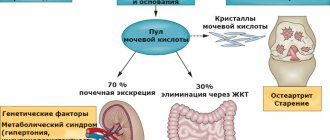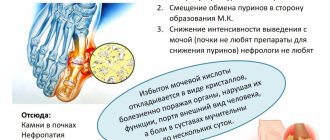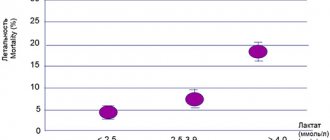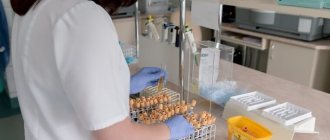Gout
Diabetes
Atherosclerosis
41763 07 April
IMPORTANT!
The information in this section cannot be used for self-diagnosis and self-treatment.
In case of pain or other exacerbation of the disease, diagnostic tests should be prescribed only by the attending physician. To make a diagnosis and properly prescribe treatment, you should contact your doctor. We remind you that independent interpretation of the results is unacceptable, the information below is for reference only
: indications for use, rules for preparing for the test, interpretation of the results and normal indicators.
Indications for prescribing the study
Uric acid is a product of the exchange of purine bases that are part of complex nucleoprotein proteins.
The precursors of uric acid are purines (guanine and xanthine - components of the nucleic acids DNA and RNA), which are formed endogenously or come from food, as well as purine nucleosides, from which adenosine triphosphate (ATP) and similar compounds are formed. Under the influence of enzymes in tissue cells, nucleic acids disintegrate.
Uric acid is synthesized mainly in the liver. In blood serum it is present in the form of sodium salt (urate) in a concentration close to saturation and is poorly soluble in water. If the threshold concentration is exceeded, sodium salts may crystallize. The higher the serum uric acid level, the higher the risk of developing a disease such as gout.
The formation of monosodium urate crystals occurs when the concentration of uric acid in the blood serum is above 420 µmol/l. In some cases, crystal formation is possible at lower levels (360 µmol/l).
Crystal deposition occurs in articular and/or periarticular tissues, kidneys and other organs in the form of tofus (lat. tofus
- porous stone). The disease most often affects the big toe, foot, ankle, knee, fingers, wrist and elbow, but can affect any joint. The deposition of monosodium urate crystals in the synovial fluid and nearby tissues triggers a cascade of immune reactions. The presence of monosodium urate crystals in the joints and surrounding tissues causes a chronic inflammatory process.
Two-thirds of uric acid is excreted by the kidneys. One third of uric acid is metabolized in the intestine by intestinal bacteria. Typically, the processes of synthesis and excretion of uric acid are balanced.
An increase in uric acid in the blood can occur for several reasons:
- with a decrease in the excretion of uric acid in the urine due to impaired renal function, a decrease in the volume of extracellular fluid, under the influence of alcohol and certain medications, fasting, etc.);
- with an increase in its production in the body:
- with excessive intake of purines from food (purines are found in large quantities in fatty meat, liver, kidneys, meat extracts, dry wine, beer, etc.);
- with increased breakdown of liver cells in chronic alcoholism, hemoblastosis, paraproteinemia, chronic hemolysis, antitumor therapy.
Eating high amounts of animal protein, being overweight, high blood pressure, alcohol, diuretics, insulin resistance, hematologic cancer, and other factors can increase uric acid levels and contribute to the development of gout.

Thus, the indications for prescribing an analysis for uric acid levels are the following diseases and conditions:
- primary gout;
- secondary gout, which occurs against the background of diseases with excessive formation of uric acid or impairing its excretion:
- acute infectious diseases (pneumonia, erysipelas, tuberculosis, etc.),
- diseases of the liver and biliary tract,
- diabetes mellitus with acidosis,
- psoriasis, eczema, urticaria,
- kidney diseases,
- acute alcohol intoxication,
- lymphoproliferative diseases, leukemia.c
Concept of uric acid in blood
Uric acid is defined as a substance formed as a result of the breakdown of nucleic compounds and purines under the influence of enzymes. It was discovered in the 18th century as part of urine and the stones present in it.
It is not used in the body's work and is classified as nitrogenous waste - the final product of purine metabolism. When a substance is formed in an excessive volume, the kidneys are not able to remove it completely; it enters the blood, so the concentration in the blood plasma increases. An increase in uric acid in the blood is called hyperuricemia.
The level of uric acid in the body is affected by:
- the amount of animal protein coming from food;
- metabolic rate;
- age;
- gender - in men, due to greater muscle volume, heavy loads and the presence of protein in the diet, the level is higher than in women.
Donating blood to determine the concentration of a substance allows you to assess the metabolism of purines in the body, the volume of their intake, transformation and excretion through the kidneys. Thus, the doctor draws conclusions about the functioning of the hematopoietic system, kidneys and liver, and muscle fibers.
Most often, the analysis is used to diagnose gout, monitor the tolerability of chemotherapy, to identify urolithiasis and evaluate the functioning of the urinary system in general and its individual components.
What can affect the result
- The following medications can lead to an increase in uric acid in the blood serum: thiazide diuretics, anabolic steroids, nicotinic acid, epinephrine, caffeine, vitamin C, beta-blockers, furosemide, calcitriol, ethacrynic acid, cyclosporines, cisplatin, asparginase, clopidogrel, diclofenac , ibuprofen, isoniazid, ethambutol, indomethacin, piroxicam.
- A decrease in uric acid in the blood serum can be caused by taking allopurinol, amlodipine, verapamil, chlorprothixene, vinblastine, methotrexate, glucocorticoids, imuran, warfarin, levodopa, methyldopa, contrast agents, spironolactone, azathioprine estrogens.
What indicator is considered normal?
During puberty, the amount of uric acid begins to gradually increase and reach levels characteristic of adults.
Men have more stable values throughout life: from 210 to 420 µmol/l.
For women of reproductive age, the level decreases due to the hormone estrogen and ranges from 150 to 350 µmol/l. When reaching the age of decline of childbearing function, the concentration increases.
The limit value, the achievement of which serves as a basis for recognizing hyperuricemia, is 360 µmol/l. At this value, the likelihood of gout in men increases by four times, in women by seventeen times. A lower value does not prevent the dissolution of urate crystals and prevent their formation.
Thus, the level of uric acid in the blood is as follows:
- in children under 14 years of age – from 120 to 320 µmol/l;
- in women – from 150 to 320 µmol/l;
- in men – from 210 to 420 µmol/l;
- at the age of 65 years – up to 500 µmol/l.
The tests must be interpreted by a doctor who evaluates several indicators in combination.
How to normalize acid levels
To normalize the concentration of salts of this acid, a specialist prescribes a course of specific treatment. It should be combined with a diet that can eliminate the alarming symptoms.
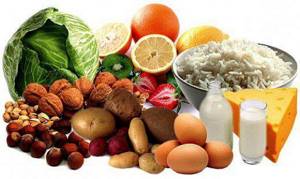
A large number of people seek to lower uric acid in the blood using folk remedies. Traditional medicine methods, of which there are a large number, often allow you to bring the acid level back to normal.
Nettle juice helps remove excess of this acid from the body. It is recommended to take it several times a day, a teaspoon.
A decoction of lingonberry leaves, prepared according to a specific recipe at home, also helps remove acid salts from the human body.
Effective remedies prepared from a decoction of birch leaves, infusions of calendula, sage and chamomile also help to normalize the amount of uric acid in a fairly short period of time.
When uric acid in the blood is reduced, the reasons for its increase are eliminated, the patient does not feel unwell. But you shouldn’t relax, in order to get rid of these problems forever, it is recommended to exercise and eat right.
What can deviations in an analysis result from the norm indicate?
Elevated uric acid results may indicate a number of conditions:
- gout;
- kidney stones or kidney failure;
- excessive consumption of foods rich in purines;
- heavy physical activity;
- weight loss, prolonged hunger;
- tissue degradation;
- eclampsia and preeclampsia in pregnant women.
Low uric acid test results (hypouricemia) may indicate:
- condition after treatment of gout (treatment with allopurinol);
- liver damage;
- ulcerative colitis.
If the test result is abnormal, it is recommended to consult with a urologist, who will help determine the cause of the deviation and give recommendations on the need for additional tests and treatment.
If you find an error, please select a piece of text and press Ctrl+Enter
Complexes with this research
Monitoring diabetes Monitoring the condition of patients with diabetes (every 6 months) 1,900 RUR Composition
Blood biochemistry. 19 indicators Advanced biochemical blood test 6,280 R Composition
Advanced male anti-aging diagnostics Advanced monitoring of key indicators in men aged 40+ RUR 33,710 Composition
IN OTHER COMPLEXES
- Inflammation of the joints 860 R
- Advanced women's anti-aging diagnostics RUB 28,680
- Male anti-aging diagnostics RUB 13,300
- Nutritionist recommends RUB 7,570
- Advanced anti-aging diagnostics in postmenopause RUB 29,230
When, where and how should you take a blood test for uric acid levels?
A biochemical blood test will show the level of uric acid. The analysis is carried out for preventive purposes for healthy people, and also patients diagnosed with diseases that predetermine a delay in its removal from the body are examined. Such diseases include: diseases of the cardiovascular system, diabetes, gout, and so on.
The objectivity of the indicators is seriously affected by the patient’s preparation for testing. To get a reliable result, the patient should not eat juices (fruit and vegetable), drinks (alcohol and caffeine), or chewing gum the day before the procedure. In addition, it is recommended to reduce the level of physical and mental stress. Blood is donated on an empty stomach in the morning; food in the evening should be no later than twelve hours before donation. It is prohibited to smoke for at least one hour before taking blood for analysis.
Venous blood from vessels passing in the cubital fossa is suitable for research. The blood taken is examined within 24 hours, and the patient receives the result the next day. If it is necessary to conduct a blood test urgently, then it is carried out within two to three hours.
Causes of increased uric acid in the blood
Reasons why uric acid in the blood is elevated include:
- gout;
- pathologies of the endocrine glands;
- blood diseases, including leukemia;
- a disease of hereditary nature, expressed in enzyme deficiency and increased production of uric acid in childhood (Lesch-Nyhan syndrome);
- multiple myeloma;
- cancer of the lymphatic system;
- anemia caused by vitamin B12 deficiency;
- kidney pathologies, including polycystic disease, renal failure, kidney stones;
- disproportionate growth of body parts due to hormonal imbalance;
- diabetes;
- hypoparathyroidism;
- eating disorders: abuse of alcoholic beverages, protein foods or prolonged abstinence from food;
- excess body weight, atherosclerosis;
- hypertension, ischemic heart disease,
- the use of certain drugs - diuretics, aspirin, antitumor drugs;
- complication of pregnancy with toxicosis;
- neoplasms of a malignant nature.
Knowing the cause of hyperuricemia is important for choosing treatment methods and preventing dangerous complications.
Reasons for low uric acid in the blood
The level of uric acid in the blood may be low if:
- Konovalov-Wilson disease, manifested in excessive accumulation of copper in the body and serious damage to systems and organs;
- congenital pathology of the renal tubules;
- xanthinuria;
- taking medications for gout, drugs for contrast X-rays, immunosuppressants, steroid hormones;
- lymphogranulomatosis;
- diet low in purines.
Detection of low levels is less common; a specialist should draw conclusions about pathology or a variant of the norm.
How to lower the level in the body
If the pathology was identified in the early stages and the increase in uric acid concentration is insignificant, you can regulate its level with folk remedies without resorting to medications. For example, use for these purposes:
- Apple vinegar. This product restores the alkaline balance in the body and effectively removes excess urea. To prepare a healthy drink, you need to take 1 tbsp. l. vinegar and dissolve in a glass of clean drinking water. The total volume should be divided into three servings and drunk throughout the day;
- citruses. Their action is similar to apple cider vinegar, so you can replace the latter with lemon juice. Squeeze one medium lemon per glass of water. The infusion should be drunk in the morning, on an empty stomach;
- baking soda. Effectively neutralizes uric acid and prevents kidney stone formation. To prepare the medicine, you need to take half a tablespoon of soda and dissolve it in a glass of water. The maximum course of treatment is 2 weeks, since soda has a side effect in the form of increased blood pressure.
The simplest and most effective way to prevent an increase in the concentration of uric acid in the body is to drink clean drinking water without gas. It improves filtration processes in the kidneys, resulting in toxins being eliminated naturally. The daily norm is 30 grams of liquid per 1 kg of weight for women and 40 grams per 1 kg of weight for men.
However, it is important to understand that any of these methods must first be agreed with your doctor. It is unacceptable to self-medicate and prescribe yourself certain medications or nutritional supplements.

Acid level test
It is possible to obtain information about the acid content in the blood only by resorting to a special analysis. Doctors prescribe it in certain cases:
- When symptoms of gout appear.
- To identify the causes that led to the formation of kidney stones.
- For kidney diseases.
- If the patient has been taking potent medications for a long time.
- The patient began to lose weight sharply.
This test allows you to determine whether uric acid in the blood is high or low. The causes of this condition need to be clarified.

Before taking the test, you should not introduce excessive amounts of sweet and salty foods into your diet, or drink alcohol-based drinks. It is not recommended to smoke an hour before the test. Taking medications may also affect the results of this test.
References
1. Hille R. Structure and Function of Xanthine Oxidoreductase (English) // European Journal of Inorganic Chemistry, 2006. doi:10.1002/ejic.200600087 2. McCarthy DJ, Hollander JL Identification of urate crystals in gouty synovial fluid. // Annals of Internal 7 - 1961. - Vol. 54. - P. 452. 3. Association of General Practitioners (Family Doctors) of the Russian Federation CLINICAL GUIDELINES FOR DIAGNOSIS AND TREATMENT OF GOUT IN GENERAL PRACTICE 2013 4. CLINICAL PROTOCOL FOR DIAGNOSIS AND TREATMENT. GOUT ARTHRITIS. 5. Diagnosis and treatment in rheumatology. Problematic approach. Pyle K., Kennedy L. Translation from English. /Ed. N.A. Shostak, 2011 6. Rheumatology: Clinical guidelines / Ed. Academician RAMS E.L. Nasonova. – 2nd ed., rev. and additional - M.: GEOTAR-Media, 2010. - 752 p. 7. Clinical recommendations. Rheumatology. 2nd edition. Ed. E.L. Nasonova, 2010 8. Rheumatology: national guide/Ed. E.L. Nasonova, V.A. Nasonova. - M.: GEOTAR - Media, 2010 - 711 p.


